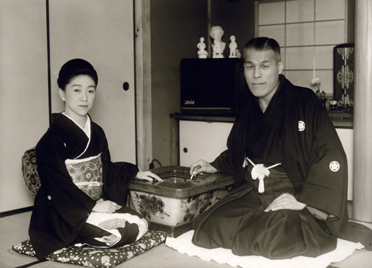| Brothers in Sumo – part two Brian Lewin |

 |
| Yokozuna Comparisons Joe Kuroda |

 |
| Rikishi of Old John Gunning |

 |
| Heya Peek Barbara Ann Klein |

 |
| SFM Interview John Gunning |

 |
| Sumo 101 Barbara Ann Klein |

 |
| Photo Bonanza See the Hatsu Basho |
 |
| Hatsu Basho Review Lon Howard |

 |
| Lower Division Rikishi Mikko Mattila |

 |
| Haru Basho Forecast Pierre Wohlleben & Mark Buckton |

 |
| Kimarite Focus Mikko Mattila |
 |
| Minusha John McTague |
 |
| Online Gaming Alexander Nitschke |

 |
| Kokugi Connections Todd Lambert |

 |
| Fan Debate Feb's debate sees |
 |
SFM Cartoons
Benny Loh & Stephen Thompson
In the third of our cartoon bonanzas, sit back and enjoy BL’s offerings and put a caption to ST’s pic to win yourselves a banzuke
| Let’s Hear From You What was it that |

 |
| Readers’ Letters See what some SFM |

 |
Sumo Quiz
The Quizmaster
Answer the Qs and win yourself next basho’s banzuke.

Oyama oyakata and okamisan. This photo was taken around 1958 and in the background can be seen one of the first TV sets available in Japan covered by a black cloth (Photo by Kudo Shashin-kan)
Next
This meteoric rise coincided with the earthshaking upheaval that was the Shunjuen incident, which occurred after his second tournament in sumo’s top flight. (described in detail in Issue 2 of SFM). Although Minanogawa from Takasago joined the rebels, Takanobori decided it was in his own best interests to stay with the kyokai. His debut at komusubi in the shortened tournament of February 1932 ended with a disappointing 3-5, but, his golden period followed soon thereafter and in the 12 months between May 1932 and May 1933, Takanobori achieved
Three tournaments into his comeback, Takanobori had managed to return to sekiwake when, on the 7th day of the may 1935 basho, he came up against the similarly-ranked Shinkai, a
